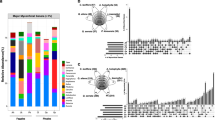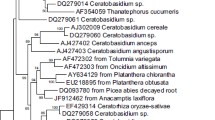Abstract
Most studies on the host preference of orchids have focused on the association between orchids and host characteristics, but little is known about the differences of mycorrhizal and endophytic fungal communities in epiphytic orchids growing on different host tree species. We selected Dendrobium sinense, a tropical epiphytic orchid, to determine if fungal endophytes from the roots of D. sinense were preferentially correlated with host tree species. Fifty-six fungal operational taxonomic units (OTUs) from 36 host trees were identified. The results indicated that the species richness and diversity of mycorrhizal and endophytic fungal communities isolated from D. sinense roots were strongly influenced by host tree species. Both species richness and diversity indices showed that D. sinense roots on Syzygium buxifolium harbored the most diverse and abundant endophytic fungi. Species of Tulasnellaceae were dominant on S. buxifolium and Rhododendron moulmainense but infrequent on Cyclobalanopsis disciformis and Podocarpus neriifolius. Our results provide evidence for distinct mycorrhizal and endophytic fungal communities on different host tree species. Further research focusing on fungi-orchid-host preference could be conducted to increase our understanding for the in situ conservation of epiphytic orchids.



Similar content being viewed by others
References
Alexander C, Hadley G (1983) Variation in symbiotic activity of Rhizoctonia isolates from Goodyera repens mycorrhizas. Trans British Mycol Soc 80:99–106
Arditti J, Ernst R, Yam TW, Glabe C (1990) The contributions of orchid mycorrhizal fungi to seed germination: a speculative review. Lindleyana 5:249–255
Bailarote BC, Lievens B, Jacquemyn H (2012) Does mycorrhizal specificity affect orchid decline and rarity? Am J Bot 99(10):1655–1665
Bayman P, Otero JT (2006) Microbial endophytes of orchid roots. In: Schulz B (ed) Microbial root endophytes. Springer, New York, pp 153–173
Bayman P, Lebrón LL, Tremblay RL, Lodge DJ (1997) Variation in endophytic fungi from roots and leaves of Lepanthes (Orchidaceae). New Phytologist 135 (1):143-149
Bayman P, Gonzalez EJ, Fumero JJ, Tremblay RL (2002) Are fungi necessary? How fungicides affect growth and survival of the orchid Lepanthes rupestris in the field. J Ecol 90:1002–1008
Boddington M, Dearnaley JDW (2008) Morphological and molecular identification of fungal endophytes from roots of Dendrobium speciosum. Proceedings of the Royal Society of Queensland 114:13–17
Brundrett MC (2002) Coevolution of roots and mycorrhizas of land plants. New Phytol 154:275–304
Callaway RM, Reinhart KO, Moore GW, Moore DJ, Pennings SC (2002) Epiphyte host preferences and host traits: mechanisms for species-specific interactions. Oecologia 132:221–230
Caporaso JG, Kuczynski J, Stombaugh J et al (2010) QIIME allows analysis of high-throughput community sequencing data. Nat Methods 7(5):335–336
Chang DCN, Chou LC (2001) Seed germination of Haemaria discolor var. dawsoniana and the use of mycorrhizae. Symbiosis 30:29–40
Chen J, Hu K, Hou X, Guo S (2011) Endophytic fungi assemblages from Dendrobium medicinal plants (Orchidaceae). World J Microbiol Biotehnol 27:1009–1016
Chen J, Wang H, Guo SX (2012) Isolation and identification of endophytic and mycorrhizal fungi from seeds and roots of Dendrobium (Orchidaceae). Mycorrhiza 22:297–307
Crain BJ (2012) On the relationship between bryophyte cover and the distribution of Lepanthes spp. Lankesteriana 12(1):13–18
Cribb PJ, Lell SP, Dixon KW, Barrett RL (2003) Orchid conservation: a global perspective. In: Dixon KW, Kell SP, Barrett RL, Cribb PJ (eds) Orchid conservation. Natural History Publications, Kota Kinabalu, pp 1–24
Dearnaley JDW, Martos F, Selosse MA (2012) Orchid mycorrhizas: molecular ecology, physiology, evolution and conservation aspects. In: Hock B (ed) Fungal associations. Springer, Berlin, pp 207–230
Edgar RC (2010) Search and clustering orders of magnitude faster than BLAST. Bioinformatics 26:2460–2461
Frohlich J, Hyde KD, Petrini O (2000) Endophytic fungi associated with palms. Mycol Res 104:1202–1212
Gentry AH, Dodson C (1987) Contribution of non-trees to species richness of atropical rain forest. Biotropica 19:149–156
Gowland KM, Mathesius U, Clements MA, Nicotra AB (2007) Understanding the distribution of three species of epiphytic orchids in temperate Australian rain forest by investigation of their host and fungal associates. Lankesteriana 7:44–46
Gowland KM, van der Merwe MM, Linde CC, Clements MA, Nicotra AB (2013) The host bias of three epiphytic Aeridinae orchid species is reflected, but not explained, by mycorrhizal fungal associations. Am J Bot 100:764–777
Graham RR, Dearnaley JDW (2012) The rare Australian epiphytic orchid Sarcochilus weinthalii associates with a single species of Ceratobasidium. Fungal Divers 54:31–37
Guo LD, Hyde KD, Liew ECY (2000) Identification of endophytic fungi from Livistona chinensis based on morphology and rDNA sequences. New Phytol 147:617–630
Harvais G, Raitsakas A (1975) On the physiology of a fungus symbiotic with orchids. Can J Bot 53:144–155
Herrera H, Valadares R, Contreras D, Bashan Y, Arriagada C (2017) Mycorrhizal compatibility and symbiotic seed germination of orchids from the Coastal Range and Andes in south central Chile. Mycorrhiza 27:175–188
Jersakova J, Kindlmann P, Renner SS (2006) Is the colour dimorphism in Dactylorhiza sambucina maintained by differential seed viability instead of frequency-dependent selection? Folia Geobot 41:61–76
Lugtenberg BJJ, Dekkers LC (1999) What makes Pseudomonas bacteria rhizosphere competent?. Environmental Microbiology 1 (1):9-13
Kress W (1986) The systematic distribution of vascular epiphytes: an update. Selbyana 9:2-22
Magurran AE (1988) Ecological diversity and its measurement. Princeton University Press, Princeton
McCormick MK, Jacquemyn H (2014) What constrains the distribution of orchid populations? New Phytol 202:392–400
Nontachaiyapoom S, Sasirat S, Manoch L (2010) Isolation and identification of Rhizoctonia-like fungi from roots of three orchid genera, Paphiopedilum, Dendrobium, and Cymbidium, collected in Chiang Rai and Chiang Mai provinces of Thailand. Mycorrhiza 20:459–471
Otero JT, Ackerman JD, Bayman P (2002) Diversity and host specificity of mycorrhizal fungi from tropical orchids. Am J Bot 89:1852–1858
Otero JT, Mosquera AT, Flanagan NS (2013) Tropical orchid mycorrhizae: potential applications in orchid conservation, commercialization, and beyond. Lankesteriana 13:57–63
Rivera-Orduna FN, Suarez-Sanchez RA, Flores-Bustamante ZR, Gracida-Rodriguez JN, Flores-Cotera LB (2011) Diversity of endophytic fungi of Taxus globosa (Mexican yew). Fungal Diversity 47 (1):65-74
de la Rosa-Manzano E, Andrade JL, Zotz G, Reyes-Garcia C (2014) Epiphytic orchids in tropical dry forests of Yucatan, Mexico—species occurrence, abundance and correlations with host tree characteristics and environmental conditions. Flora 209:100–109
Sánchez MS, Bills GF, Zabalgogeazcoa I (2008) Diversity and structure of the fungal endophytic assemblages from two sympatric coastal grasses. Fungal Divers 33:87–100
Smith SE, Read DJ (2008) Mycorrhizal symbiosis. Academic Press, London
Song XQ (2005) Studies on the wild Dendrobium germplasm resources in Hainan Island with special reference to conservation biology of D. sinense. Dissertation, Beijing Forestry University.
Tamura K, Stecher G, Peterson D, Filipski A, Kumar S (2013) MEGA6: molecular evolutionary genetics analysis version 6.0. Mol Biol Evol 30:2725–2729
Thompson JD, Gibson TJ, Plewniak F, Jeanmougin F, Higgins DG (1997) The CLUSTAL_X windows interface: flexible strategies for multiple sequence alignment aided by quality analysis tools. Nucl Acids Res 25(24):4876–4882
Timsina B, Rokaya MB, Munzbergova Z, Kindlmann P, Shrestha B, Bhattarai B, Raskoti BB (2016) Diversity, distribution and host-species associations of epiphytic orchids in Nepal. Biodivers Conserv DOI. doi:10.1007/s10531-016-1205-8
Westerhuis JA, Hoefsloot HCJ, Smit S, Vis DJ, Smilde AK, Velzen EJJ, Duijnhoven JPM, Dorsten FA (2008) Assessment of PLSDA cross validation. Metabolomics 4(1):81–89
White TJ, Bruns T, Lee S, Taylor J (1990) Amplification and direct sequencing of fungal ribosomal RNA genes for phylogenetics. In: Innis MA, Gelfand DH, Sninsky JJ, White TJ (eds) PCR protocols: a guide to methods and applications. Academic Press, San Diego, pp 315–322
Wu HZ (2012) Population ecology of Dendrobium sinense (Orchidaceae), an endemic species to Hainan Island. Hainan University, Dissertation
Wu LS, Han T, Li WC et al (2013) Geographic and Tissue Influences on Endophytic Fungal Communities of Taxus chinensis var. mairei in China. Current Microbiology 66 (1):40-48
Xing YM, Chen J, Cui JL, Chen XM, Guo SX (2011) Antimicrobial activity and biodiversity of endophytic fungi in Dendrobium devonianum and Dendrobium thyrsiflorum from Vietnam. Curr Microbiol 62:1218–1224
Xing XK, Gai XG, Liu Q, Hart MM, Guo SX (2015) Mycorrhizal fungal diversity and community composition in a lithophytic and epiphytic orchid. Mycorrhiza 25:289–296
Yang FS (2009) Conservation biology on the base of endophytic mycorrhizal fungi of an endangered orchid Dendrobium sinense. Hainan University, Dissertation
Yuan ZL, Chen YC, Yang Y (2009) Diverse non-mycorrhizal fungal endophytes inhabiting an epiphytic, medicinal orchid (Dendrobium nobile): estimation and characterization. World J Microbiol Biotehnol 25:295–303
Zettler LW, Piskin KA, Stewart SL, Hartsock JJ, Bowels ML, Bell TJ (2005) Protocorm mycobionts of the federally threatened eastern prairie fringed orchid, Platanthera leucophaea (Nutt.) Lindley, and a technique to prompt leaf elongation in seedlings. Stud Mycol 53:163–171
Zhu GS, Yu ZN, Gui Y, Liu ZY (2008) A novel technique for isolating orchid mycorrhizal fungi. Fungal Divers 33:123–137
Acknowledgements
This research was financially supported by the Special Fund for Agro-scientific Research in the Public Interest (201303117) and by the Excellent Graduate Dissertation Development Scheme of Hainan University (2014), and partially supported by the National Natural Science Foundation of China (31160178). We thank Shanjiang Qi for the help on field sampling, and thank Prof. Peng Ling for the useful comments on this manuscript.
Author information
Authors and Affiliations
Corresponding author
Rights and permissions
About this article
Cite this article
Wang, X., Li, Y., Song, X. et al. Influence of host tree species on isolation and communities of mycorrhizal and endophytic fungi from roots of a tropical epiphytic orchid, Dendrobium sinense (Orchidaceae). Mycorrhiza 27, 709–718 (2017). https://doi.org/10.1007/s00572-017-0787-7
Received:
Accepted:
Published:
Issue Date:
DOI: https://doi.org/10.1007/s00572-017-0787-7




